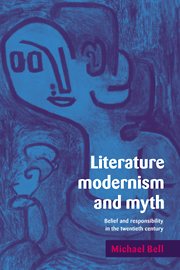5 - The break-up of modernist mythopoeia
Published online by Cambridge University Press: 18 December 2009
Summary
NOVEL, STORY AND THE FOREIGN: THOMAS MANN, CERVANTES AND PRIMO LEVI
Thomas Mann's ‘mythic phase’ was a self-conscious development starting in the late nineteen twenties, with the Joseph novels, and covering the rest of his career encompassing Doctor Faustus. If the Owl of Minerva flies at dusk, Mann's self-consciousness about the mythic makes him an excellent lens through which to consider both modernism and the period of its break-up. The historical, formal and thematic aspects involved can be approached in the sidelong fashion adopted by Mann himself in an apparently casual essay on the reading of Cervantes. In May 1934 Thomas Mann, already living in exile in Austria, made his first journey to America where he was to spend the war-time years. In the previous year Hitler had come to power and Mann had published The Tales of Jacob, the first volume of the tetralogy Joseph and his Brothers which was not to be completed until the latter part of the war. His essay ‘Voyage with Don Quixote' records his rereading of this foundational European novel on the journey. The essay is commonly read as a piece of casual journalism, but its apparent casualness is part of a highly crafted insight into Mann's consciousness of his own historical world and the contemporary significance of his mythic phase.
Mann intersperses the narrative of his voyage with passages of commentary on Don Quixote. His apparently random procedure frees him from the need to argue a case, or even to see Cervantes's text from any consistent viewpoint. But the essay interweaves several themes with the complexity and open-endedness of a work of fiction.
- Type
- Chapter
- Information
- Literature, Modernism and MythBelief and Responsibility in the Twentieth Century, pp. 161 - 181Publisher: Cambridge University PressPrint publication year: 1997



